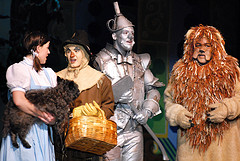 The last week or so has seen a number of blog posts from some of my favorite thinkers in the arts addressing Big Questions about arts structures in very serious ways. (The picture is related to this post’s title. Not to the bloggers!) I am not going to repeat what they said, but I’d like to highlight the issues they raise.
The last week or so has seen a number of blog posts from some of my favorite thinkers in the arts addressing Big Questions about arts structures in very serious ways. (The picture is related to this post’s title. Not to the bloggers!) I am not going to repeat what they said, but I’d like to highlight the issues they raise.
First, Adam Huttler, the Fractured Atlas guru, responded (in Swimming Downstream in the Current of History) to Michael Kaiser’s lament about all the talk of “new models” for the arts. Mr. Huttler has put together an incredibly thoughtful analysis of the “models” discussion. For me, the bottom line is his concluding observation, “remind yourself that you’re in the art business, not the organization business.” As many of us say, the libraries that discovered decades ago that they were about information access rather than books (primarily) are the ones that are thriving today. (Mr. Huttler cites railroads and transportation, but it’s the same point.) Where I would go a step further than Mr. Huttler did in his post is to say that there will also be significant shakeout in arts product over the next several generations in response to changing demographics and the practical need to be meaningful to larger percentages of the population. (Richard Evans from EmcArts weighed in on this topic as well.)
Second, Diane Ragsdale has been at it again. In As nonprofits do we (or should we) put all art in service of instrumental ends? she deals with, among other things, the question of the suitability of 501c3 status for organizations whose focus is solely (or primarily) on the art product as opposed to on the point of intersection between the art and the community. The forming language of the tax code cites “charitable” and “educational” as the only two criteria that are applicable to arts organizations. (As many have noted, the word “art” does not appear at all.) The tax code holds that the public good must be the principal motivation of nonprofits. Ms. Ragsdale inquires whether, by and large, the arts subsector of the nonprofit world sees things that way.
. . . do the majority of artistic leaders even think about the works they are producing or presenting as being in service of educational or social goals? Or do they simply program works they like and believe in, regardless of such instrumental ends?
I would have to say that these seem to me to be rhetorical questions. Both in the origins of long-standing arts organizations and in the formation of new ones, much of the time the motivation has been to serve art, not the public. I’m not saying such service is a bad thing. But it is not a thing for which the tax code was designed. If I may be permitted to say out loud what in my bones I know a number of people think, there is a good deal of the arts world that looks at the 501c3 structure with its volunteer board of directors, financial reporting requirements, and public service mandate as a (perhaps necessary) evil, as a means to do what it is they want to do.
And Clayton Lord, in anticipation of a TCG panel presentation with Ms. Ragsdale, has contributed to the discussion in First the Seed: Embracing Arts as a Means to and End. He reminds us to focus on the art rather than the model or the structure. In a way, that’s a good deal like what Mr. Huttler was saying, but perhaps coming from 180° around the circle.
We are in an era in which politicians and the public are taking long, hard looks at nonprofits. Large hospitals and universities are being asked (and strong-armed) into paying PILOT (payments in lieu of taxes). The benefits of deductible contributions and no income or property tax will be increasingly scrutinized. Insofar as organizations are not seen to be furthering the public good (in a broad understanding of “public”), the legitimacy of those benefits will be called into question more and more.
So discussion of the public service nature of not-for-profit arts organizations is timely. The arc of public discourse surrounding tax benefits for 501c3’s may well be bending in the direction of the arts. Knowing what we think about the questions that will be raised and being prepared to address them will be increasingly critical for the arts based in this model.
All of this has gotten me thinking again about these issues and community engagement. (Surprised, right?!) Be warned. More is coming on the topic.
Engage!
Doug
Photo![]()
![]() Some rights reserved by ISD 191 Performing Arts Programs
Some rights reserved by ISD 191 Performing Arts Programs
